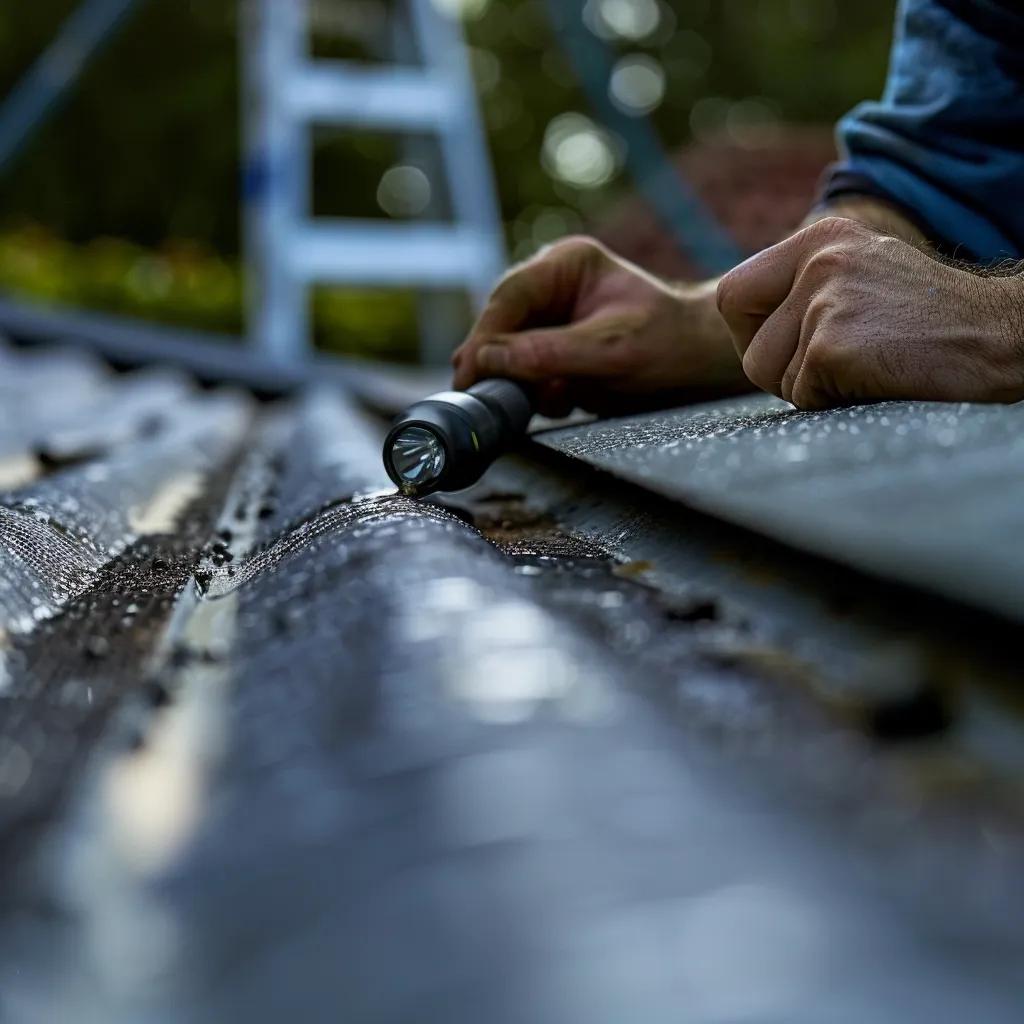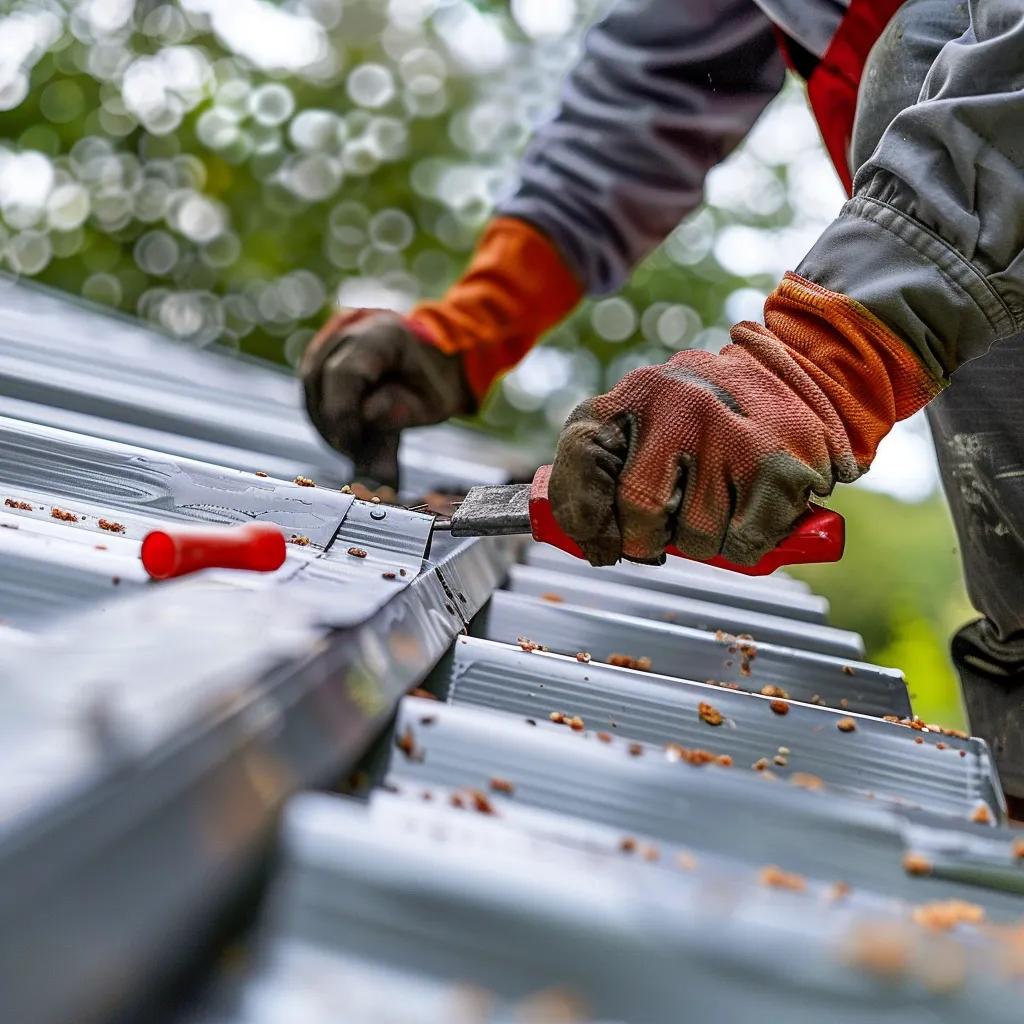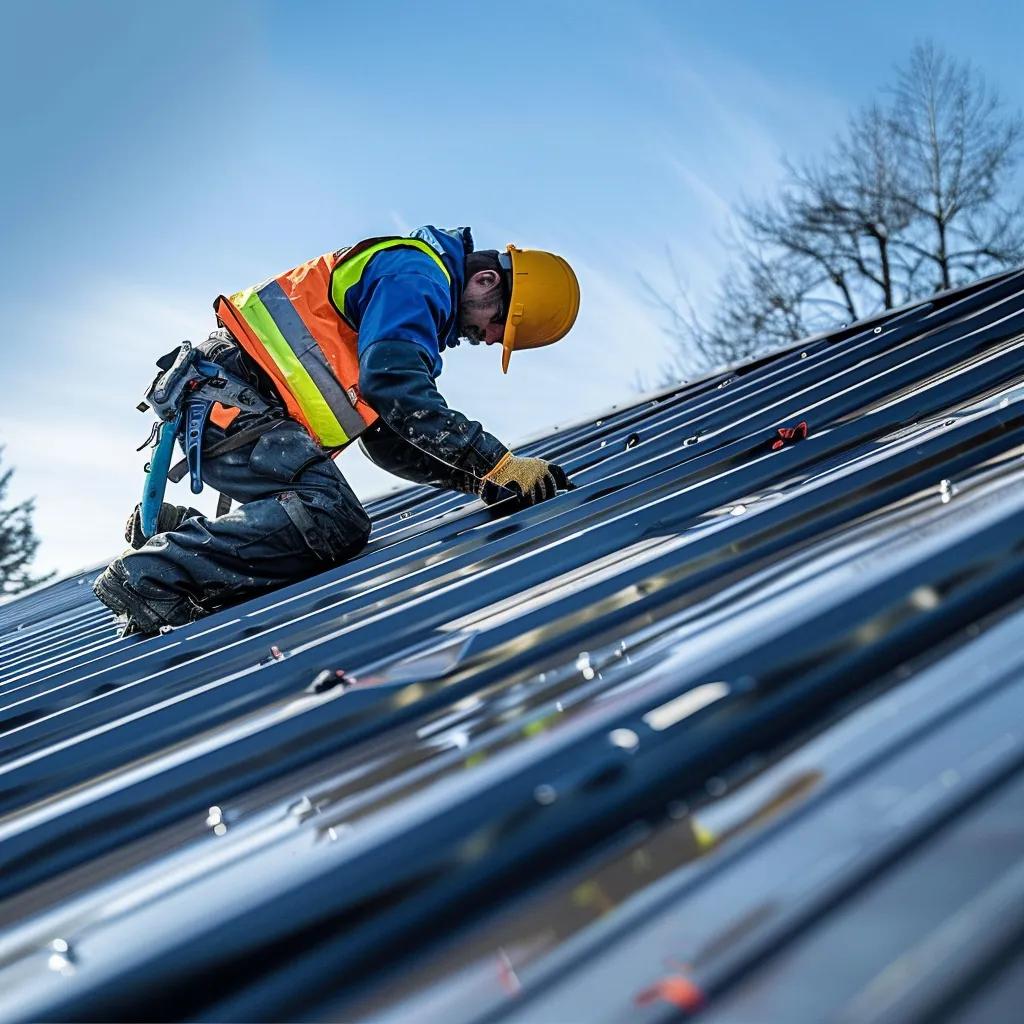Comprehensive Guide on How to Repair a Metal Roof Leak: Expert Tips for Effective Leak Detection and Repair
Metal roofs, prized for durability and energy efficiency, can still develop leaks that compromise your home’s integrity and lead to costly water damage if not addressed promptly. This comprehensive guide on metal roof leak repair unpacks the most common causes, step-by-step detection methods, DIY fixes, and professional solutions from Storm Choice Roofing in Houston, TX. You’ll learn how to spot interior and exterior signs of leaks, apply temporary sealants, understand when to call in certified technicians, and implement preventative maintenance to extend roof lifespan.
What Are the Most Common Causes of Metal Roof Leaks?
Metal roof leaks arise from a handful of predictable failure points where water can breach the weather barrier. Understanding these root causes is the first step toward reliable repair and long-term protection.
Causes of Metal Roof Leaks
Metal roof leaks can arise from various factors, including fastener issues, seam failures, and damage from storms. Fasteners can fail when screws lose compression, allowing water intrusion. Seams and overlaps are vulnerable due to sealant degradation or capillary action. Storm damage, such as hail or high winds, can also compromise the roof’s integrity.
Smith, A., “Metal Roofing Failures and Solutions” (2022)
This research provides a general overview of the common causes of metal roof leaks, which is relevant to the article’s discussion of leak detection and repair.
How Do Fastener Issues Like Screws Cause Metal Roof Leaks?
Fastener failures occur when roofing screws lose compression on their rubber washers or penetrate improperly, allowing water intrusion.
- Screws Over-driven → Washer crushed → Seal breaks
- Screws Under-driven → Washer not seated → Loose fastener
- Worn Washers → Rubber degrades → Water seeps around screw
Repairing or replacing faulty screws restores the watertight seal at each penetration and prevents leaks from spreading into the roof deck.
Why Do Seams and Overlaps Develop Leaks on Metal Roofs?
Seams and overlaps rely on sealant integrity and tight panel alignment; when sealant erodes or capillary action draws water upward, leaks form.
- Deteriorated Sealant → Cracks form → Water migration
- Capillary Action → Moisture pulled into gaps → Hidden leaks
- Misaligned Panels → Uneven overlap → Insufficient coverage
Re-sealing seams with appropriate compound and realigning panels stops capillary-driven leaks and secures panel joints.
How Does Flashing Failure Lead to Metal Roof Leaks?
Flashing channels water around penetrations; when it cracks, rusts, or lifts, water bypasses the roof membrane at chimneys, vents, and skylights.
- Damaged Chimney Flashing → Gap around masonry → Leak into attic
- Cracked Valley Flashing → Joint separation → Runoff intrusion
- Loose Skylight Flashing → Unsealed edge → Rain entry
Inspecting and patching flashing or installing new pre-formed units restores continuous water diversion around vulnerable roof intersections.
What Role Does Rust and Corrosion Play in Metal Roof Leak Formation?
Rust weakens metal panels by eating through paint and substrate, eventually creating pinholes that allow steady drips.
- Protective Coating Wears → Bare metal exposed → Oxidation begins
- Surface Rust → Weak spot formation → Corrosion spreads
- Through-Panel Holes → Direct water entry → Uncontrolled leaks
Removing rust, applying rust-inhibiting primer, and recoating panels halts corrosion and seals small holes before they grow.
How Does Storm Damage Affect Metal Roof Leak Risks?
Hail strikes, high winds, and flying debris dent panels, loosen fasteners, or tear sealant, producing new leak points.
- Hail Impacts → Dents crack paint → Exposed metal
- Wind Uplift → Fasteners loosen → Panel shift
- Branch Debris → Scratch coating → Corrosion socket
Repairing storm damage restores panel integrity and prevents secondary leaks from compromised areas.
Can Improper Installation Cause Metal Roof Leaks?
Incorrect panel alignment, wrong fastener spacing, and omitted underlayment create systematic vulnerabilities, leading to widespread water penetration.
- Undersized Underlayment → Inadequate water barrier
- Misplaced Screws → Missed framing → Loose panels
- Incomplete Sealant Application → Unprotected seams
A professional inspection can pinpoint installation errors and guide targeted repairs or retrofit measures.
How Can You Identify a Metal Roof Leak? Step-by-Step Leak Detection Methods

Metal Roof Leak Detection
Identifying the source of a metal roof leak is crucial for effective repair. Interior signs like water stains and mold can indicate a leak’s location. Exterior inspections should include checking for rust, missing fasteners, and damaged flashing. A water hose test can simulate rainfall to pinpoint elusive leaks.
Jones, B., “Roof Leak Detection Methods” (2023)
This research supports the article’s guidance on how to identify metal roof leaks through various inspection methods.
What Interior Signs Indicate a Metal Roof Leak?
- Water Stains on Ceiling → Brown rings or spots
- Sagging Drywall → Moisture-softened gypsum
- Mold or Mildew in Attic → Persistent humidity zones
Visible interior damage often corresponds to exterior breach locations, guiding your inspection.
How to Perform an Exterior Visual Inspection for Metal Roof Leaks?
- Scan for Rust Spots → Corroded paint or metal
- Check for Missing Fasteners → Exposed screw holes
- Look at Bent Panel Edges → Gaps at seams
- Inspect Flashing and Sealant Lines → Cracks or lifts
- Clear Clogged Gutters → Overflow backups
Addressing these visible issues often stops leaks without extensive removal of roofing materials.
How Is a Water Hose Test Used to Pinpoint Metal Roof Leaks Safely?
A controlled hose test simulates rainfall on specific roof zones to locate elusive leaks.
- Method: Gently spray one section at a time from gutter to ridge
- Duration: 5–10 minutes per zone for realistic water flow
- Safety: Secure ladder, use safety harness, avoid oversaturation
Once water visibly drips indoors, mark the area on the roof, then drain and dry surfaces before repair.
When and How Can You Fix Metal Roof Leaks Yourself? DIY Repair Techniques and Limitations
What Are Minor Metal Roof Leak Fixes You Can Do at Home?

Temporary solutions can stem small leaks until a permanent fix:
- Tightening Loose Screws: Use a rubber-washered roofing screw gun
- Applying Sealant to Small Cracks: Clean surface, apply silicone or butyl compound
- Patching Small Holes: Back-butter metal patch with roofing cement
These actions restore immediate water resistance but should be followed by full repairs to ensure longevity.
Which Sealants Are Best for Repairing Metal Roof Leaks?
| Sealant Type | Key Property | Best Application |
|---|---|---|
| Silicone | UV-resistant & elastic | Sealing screw heads and minor surface cracks |
| Butyl | High adhesion & waterproof | Sealing seams and panel overlaps |
| Polyurethane | Paintable & weather-tolerant | Flashing edges and larger panel repairs |
What Tools and Materials Are Needed for DIY Metal Roof Leak Repairs?
A concise toolkit enables safe, effective temporary repairs:
- Non-slip Ladder and Safety Harness
- Screwdriver or Screw Gun with Sealing Washers
- Silicone and Butyl Sealants
- Metal Patch Pieces and Roofing Cement
- Wire Brush, Cleaner, and Rags
Having the correct tools reduces risk of accidental damage and ensures a tighter seal.
What Safety Precautions Should You Take When Repairing a Metal Roof?
- Use a Secure Ladder with Proper Angle
- Wear Rubber-soled, Slip-resistant Footwear
- Employ a Fall Arrest System or Harness
- Work During Dry, Low-wind Conditions
- Consult a Professional for Steep or High-profile Roofs
Safe practices protect you physically and preserve roof integrity during repairs.
Why Should You Call a Professional for Metal Roof Leak Repair? Storm Choice Roofing’s Expert Services
When Is Professional Metal Roof Leak Repair Necessary?
Calling in professionals is advisable when:
- Damage Extends Beyond Minor Seal Breaks
- Structural Components Show Rot or Sagging
- Leaks Are Hard to Locate or Recurring
- Safety Risks Exceed DIY Precautions
What Makes Storm Choice Roofing the Trusted Metal Roof Repair Expert in Houston, TX?
Storm Choice Roofing combines regional weather knowledge, storm-damage specialization, and certified technicians to deliver precise leak repairs. Local offices in Conroe, Humble, and Richmond ensure quick response times and personalized service.
What Is the Typical Process for Professional Metal Roof Leak Repair?
Storm Choice Roofing follows a structured four-step workflow:
- Inspection: Full interior and exterior assessment
- Diagnosis: Leak source mapping and extent evaluation
- Repair Plan: Customized scope, materials, and timeline
- Quality Assurance: Post-repair testing and homeowner review
This proven approach restores roof performance and prevents future leaks.
How Much Does Professional Metal Roof Leak Repair Cost?
| Repair Type | Typical Cost Range | Cost Drivers |
|---|---|---|
| Screw Replacement | $50–$150 | Number of screws, height access |
| Seam Resealing | $250–$1,100 | Length of seam, sealant brand |
| Flashing Repair | $300–$900 | Flashing material, roof slope |
| Panel Replacement | $500–$1,500 | Panel size, coating match |
Accurate estimates depend on a complimentary inspection—call Storm Choice Roofing at (832) 971-5495 to schedule.
How Can You Prevent Future Metal Roof Leaks? Essential Maintenance Tips for Longevity
How Often Should You Schedule Metal Roof Inspections?
| Inspection Type | Frequency | Key Action |
|---|---|---|
| Annual Visual Inspection | Once per year | Check fasteners, sealants, flashing |
| Post-Storm Inspection | After major storms | Look for hail dents, debris impact |
| Gutter Cleaning | Twice per year | Remove leaves, ensure proper water flow |
| Sealant Reapplication | Every 3–5 years | Evaluate and reseal seams and panel overlaps |
Why Is Gutter Cleaning Important for Metal Roof Leak Prevention?
Clear gutters and downspouts direct runoff away from the roof edge, preventing water backup under panels. Debris-clogged channels force water to pool at seams, accelerating corrosion and seam failures.
How Does Trimming Overhanging Branches Protect Your Metal Roof?
Removing branches that scrape or fall onto the roof prevents punctures, scratches, and sealant abrasion. Regular tree maintenance also reduces debris accumulation that can trap moisture and foster rust.
When and How Should Sealants and Roof Coatings Be Maintained?
Sealants and coatings lose elasticity over time; proactive reapplication every 3–5 years preserves waterproofing. After cleaning the surface, apply manufacturer-recommended compounds in mild weather to ensure proper curing and adhesion.
What Are the Signs You Need a Metal Roof Inspection in Houston, TX?
How to Recognize Urgent Metal Roof Leak Symptoms?
Visible leaks, persistent water staining, and damp attic insulation signal a need for immediate intervention. If you notice dripping during light rain or fresh mold growth, schedule an inspection without delay.
How Does Storm Choice Roofing Conduct Metal Roof Inspections in Houston?
Our certified inspectors perform a comprehensive assessment that includes drone-aided aerial scans, thermal imaging to detect moisture intrusion, and detailed interior checks. This multi-method approach ensures no leak goes undetected.
How to Schedule Your Metal Roof Inspection with Storm Choice Roofing Today?
Contact our Houston team via phone at (832) 971-5495 or book online at stormchoiceroofing.com/ for a free, no-obligation inspection. Prompt scheduling secures your spot before the next storm season.
What Are the Best Practices for Repairing Specific Metal Roof Leak Causes?
How to Repair Leaky Metal Roof Screws Effectively?
Begin by removing the old screw, cleaning the hole, then installing a new rubber-washered screw through the panel into framing. Apply sealant under the washer before tightening to avoid over-compression.
What Are the Steps for Metal Roof Seam Repair?
- Clean seam area with a wire brush and solvent.
- Apply a continuous bead of butyl sealant along the joint.
- Press adjacent panel edge into sealant to form a watertight bond.
- Smooth sealant bead and inspect for voids.
Proper seam resealing stops capillary-driven leaks and reinforces panel overlaps.
How Is Metal Roof Flashing Repaired or Replaced?
Damaged flashing should be removed, substrate cleaned, and new flashing cut to match penetration shape. Secure flashing with corrosion-resistant fasteners, seal edges with polyurethane compound, and test for leaks with a hose.
How to Address Rust and Corrosion on Metal Roof Panels?
After removing rust with a stiff wire brush and applying a rust-inhibiting primer, coat the area with metal-compatible paint. For through-holes, install a metal patch underlathered with roofing cement before priming and coating.
How to Repair Storm Damage on Metal Roofs?
Dent removal tools and body filler can reshape minor hail dents. For panel tears or large perforations, replace the affected section and reseal joinery. Always inspect underlying decking for hidden water damage after major storms.
Maintaining a metal roof free of leaks demands regular attention to fasteners, seams, flashing, and coatings. By combining DIY vigilance with Storm Choice Roofing’s professional inspections and repairs, Houston homeowners can preserve their roof’s performance through all seasons. Call (832) 971-5495 or visit stormchoiceroofing.com/ today to secure your roof’s longevity with expert care.


